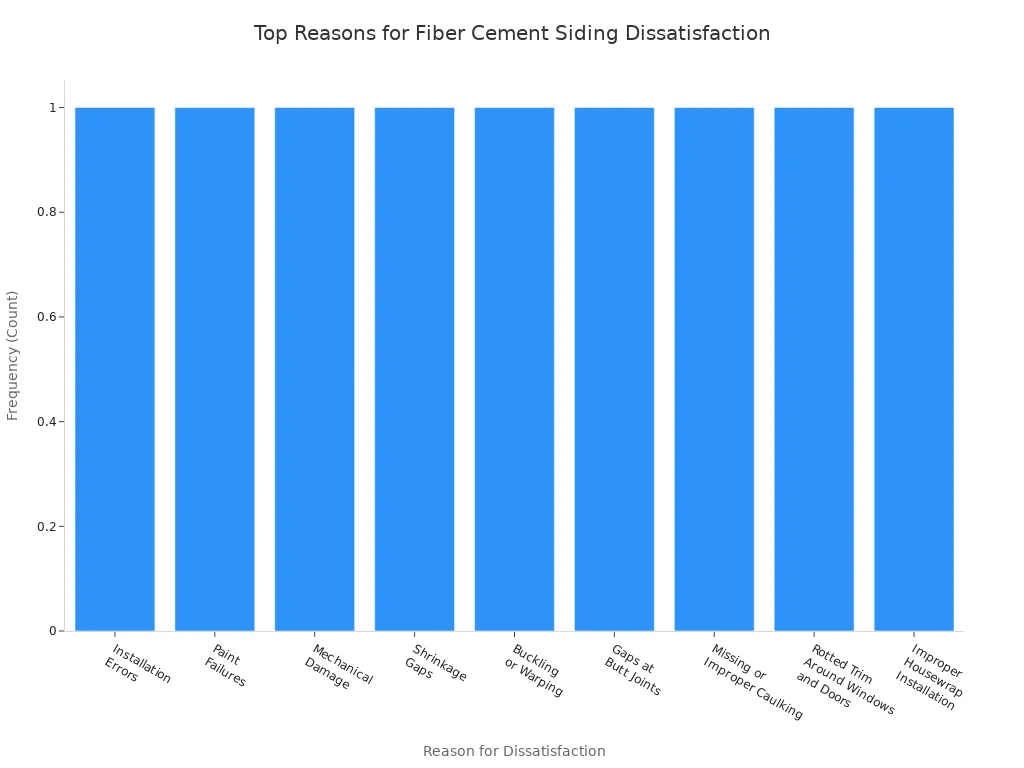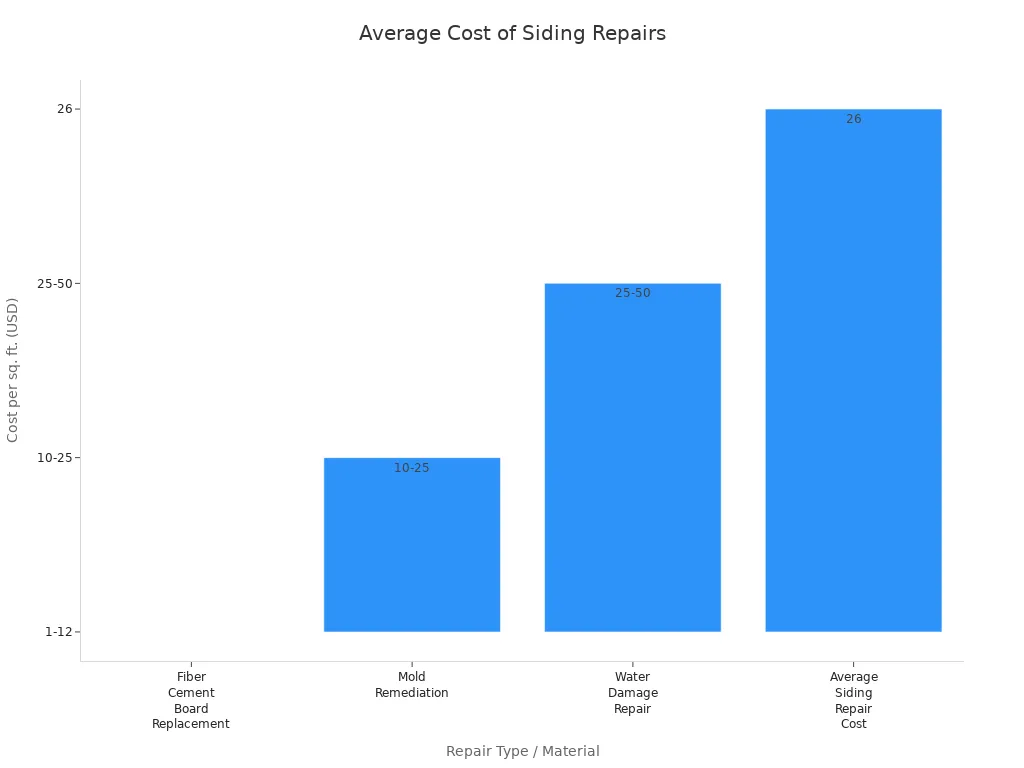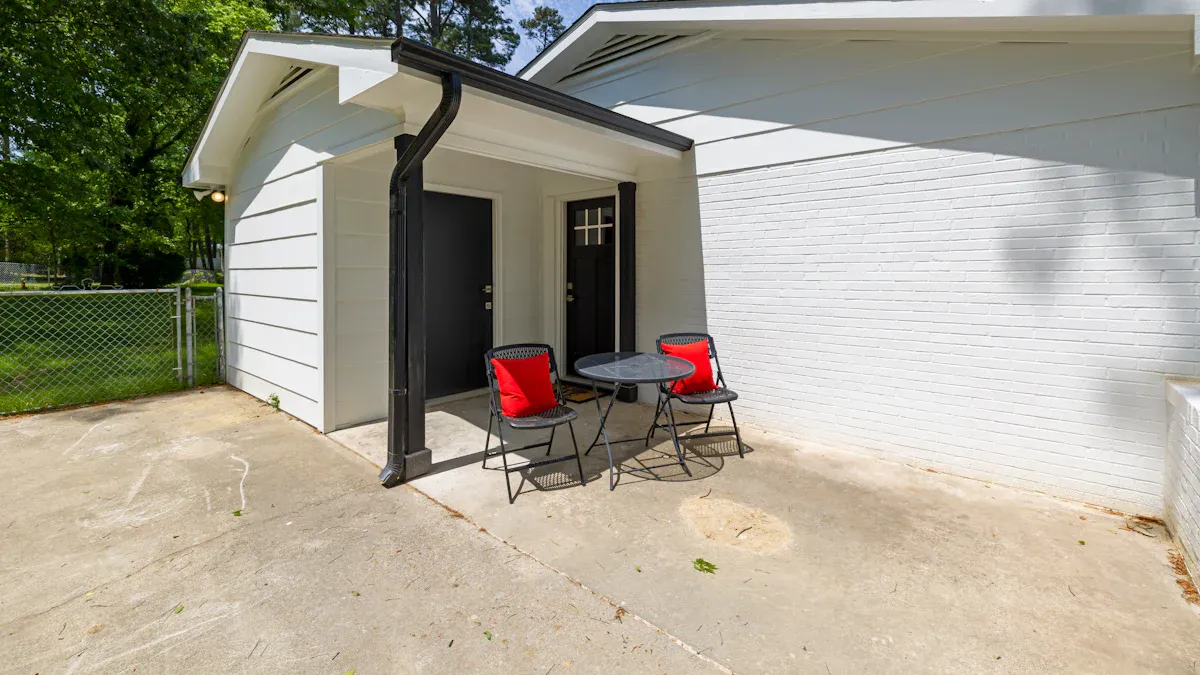


Views: 0 Author: Site Editor Publish Time: 2025-07-17 Origin: Site











You face a significant challenge when you choose fiber cement board siding—moisture absorption. This problem affects many homes across the United States. If you own a home or build for others, you know that siding must last and protect your investment. When fiber cement board siding absorbs moisture, it can lead to swelling, mold, and costly repairs.
The biggest problem with fiber cement siding is moisture absorption. This can make the siding swell, grow mold, and get damaged.
You should check and take care of your siding often. Washing and repainting it every 10 to 15 years keeps it strong. This also helps you avoid expensive repairs.
Siding needs to be installed the right way. Sealed edges, expansion gaps, and good airflow help keep water out.
Look for warning signs like cracks, bulging, peeling paint, or mold. Finding these problems early lets you fix them fast.
Taking care of your siding makes your home worth more. It also keeps your house safe from weather, bugs, and damage over time.
You might think fiber cement siding stands up to anything, but moisture can sneak in and cause trouble. The main ingredient in fiber cement board siding is cellulose fiber. This organic material absorbs water if the siding is not sealed well. When fiber cement absorbs water, it starts to swell and lose its shape. You may notice the boards begin to warp or bulge. Over time, this moisture weakens the siding, making it soft and crumbly.
Tip: Always check for cracks or gaps in your siding. Even small openings let water in and start the damage.
Moisture issues do not just stop at swelling. They create the perfect environment for mold to grow. Mold can spread behind the boards, making it hard to spot until the problem gets worse. If you ignore these signs, you risk bigger repairs and higher costs later.
Many homeowners believe fiber cement siding is maintenance-free. This is not true. You need to wash it once a year and check for any damage. If you skip these steps, moisture can get trapped and start causing problems.
Here are some common misconceptions about fiber cement siding and the facts you should know:
Misconception | Clarification |
|---|---|
Fiber cement siding is maintenance-free | It needs occasional washing and inspection to prevent moisture damage. |
Fiber cement siding lasts forever | It is durable but will wear down over time, especially if moisture gets in. |
Fiber cement siding never needs repainting | You will need to repaint it every 10 to 15 years to keep it sealed and protected. |
When moisture gets into fiber cement board siding, swelling happens first. The boards expand and push against each other. This can cause gaps at the joints or buckling along the wall. You might see the paint start to peel or bubble. These are early warning signs that moisture has gotten inside.
If you do not fix the swelling, mold will likely follow. Mold loves damp, dark spaces. It grows behind the siding where you cannot see it. Mold not only damages the siding but can also affect your health. Breathing in mold spores can cause allergies or other health problems.
Take a look at the most common reasons people feel unhappy with their fiber cement siding:

You can see that installation errors, paint failures, and moisture-related problems top the list. Most long-term problems with fiber cement siding start with moisture absorption. If you keep the siding sealed and watch for early signs, you can avoid most of these issues.
Note: Fiber cement siding problems happen less often than with wood or vinyl, but moisture remains the biggest threat. Regular care keeps your siding strong and your home safe.
You might think fiber cement siding saves money and time. But moisture can make things harder. When water gets in, you have to do more work each year. Here are some ways moisture makes upkeep harder:
You need to repaint every 10 to 15 years. Each time you repaint, it can cost $3,000 to $6,000.
Cleaning fiber cement siding needs gentle care. You cannot use a pressure washer. You must wash it by hand, which takes longer.
You have to check and caulk the siding often. If you skip these steps, water gets in and causes bigger problems.
Fiber cement siding needs more repairs than vinyl siding. It can soak up water and start to rot or grow mold.
If you do not keep up with these jobs, repairs cost even more. Look at the average costs for fixing water damage:
Repair Type / Material | Cost Range (per sq. ft.) |
|---|---|
Fiber Cement Board Replacement | $1 to $12 |
Mold Remediation | $10 to $25 |
Water Damage Repair | $25 to $50 |
Average Siding Repair Cost | Around $26 |

Tip: Check your siding every year. Fixing problems early saves money.
Fiber cement siding can last 30 to 50 years. But you must clean, repaint, and check it every year. If you do these things, the siding keeps your home safe and looking nice.
Real estate experts say fiber cement siding adds value to homes. It stands up to fire, bugs, and bad weather. Many buyers like it because it lasts long and needs less work than wood. The 2023 Remodeling Cost vs. Value Report says new fiber cement siding can give you an 88.5% return. That means you could add over $17,000 to your home's value.
But if you let water problems go, the siding can swell, crack, or get moldy. These problems make your house look worse. They also lower the price if you want to sell. Buyers see damaged siding and may pay less.
Note: Doing regular maintenance protects your home. Fiber cement siding lasts longer and keeps its value if you take care of it.

You might think fiber cement siding is tough, but its materials can cause problems. Cellulose fibers make the boards strong and help them last longer. These fibers, however, react to the environment. They can lose strength when exposed to heat, sunlight, or freezing weather. When this happens, the siding may shrink, bend, or even crack. You may notice the boards become less flexible and more brittle over time.
Poor installation creates even more issues. Many problems with fiber cement siding start when installers do not follow the right steps. Here are some common mistakes:
Nails driven too deep can crack the siding.
Nails not deep enough leave boards loose, letting in water and pests.
Using the wrong nails causes rust and weakens the siding.
Skipping expansion gaps makes boards push against each other and crack.
Missing flashing at seams lets water seep behind the siding.
Gaps around windows or doors allow moisture to get inside.
You need skilled workers who follow the manufacturer’s instructions. If they skip steps, you may see warping, rot, or mold. These problems often lead to costly repairs.
Your local climate affects how well fiber cement siding performs. In cold, wet places, this siding resists rot and mold better than wood. It stands up to freezing, rain, and even salty air near the coast. In hot areas, though, the cellulose fibers can break down. High heat causes the boards to lose elasticity and become brittle.
Humidity and heavy rain test the siding’s ability to block water. If installers do not leave enough space for the boards to expand and contract, you may see swelling or warping. Paint can also peel or bubble, leading to loss of paint adhesion. This makes the siding look old and lets in more moisture.
Other issues include weight and paint fading. Fiber cement siding weighs more than vinyl, so it sometimes needs extra support. The good news: it holds paint much longer than wood, so you repaint less often. You still need to check for fading or peeling, which can signal deeper problems.
Tip: Watch for cracks, swelling, or paint problems. Early action keeps your siding strong and your home safe.
Issue | What You Might See | What To Do |
|---|---|---|
Cracking or warping | Boards bending or splitting | Call a pro for repairs |
Mold or rot | Dark spots or soft areas | Remove and replace boards |
Loss of paint adhesion | Peeling or bubbling paint | Repaint and reseal |
You can spot trouble with fiber cement siding if you know what to look for. Early detection helps you avoid bigger repairs. Here are some warning signs you should never ignore:
Cracks or splits in the boards
Paint that peels, bubbles, or looks faded
Swelling or bulging areas on the surface
Soft spots when you press on the siding
Dark streaks or patches that could mean mold
Gaps at the joints or corners
You may also notice water stains or a musty smell near the walls. These signs often mean moisture has gotten behind the siding. If you see any of these problems, take a closer look right away.
Tip: Walk around your home twice a year. Use a flashlight to check shaded areas and spots near the ground. Catching problems early keeps your siding strong.
Here is a quick table to help you remember what to watch for:
Problem | What You See | What It Means |
|---|---|---|
Cracks | Lines or splits | Weakness, water entry |
Swelling | Boards bulging | Moisture inside |
Mold | Dark spots, odor | Trapped water |
You should act as soon as you spot any warning signs. Fiber cement siding resists water, but it is not waterproof. Moisture can sneak in and get trapped. If you ignore early damage, the problems get worse. Swelling, cracking, and mold can spread fast. You may end up needing to replace large sections of siding.
Prompt action protects your home. Patch small cracks or repaint faded spots right away. If you see bigger problems, like deep cracks or soft, rotten boards, call a professional. Waiting too long lets water get deeper into the wall. This can cause rot and even damage the structure of your house.
Note: Quick repairs keep your siding in good shape. Regular checks and fast fixes save you money and stress.
Stay alert to changes in your siding. You protect your investment and keep your home safe when you act quickly.
You can prevent most problems by following the right steps during installation. Manufacturers recommend several techniques to keep siding strong and dry:
Prime and seal all cut edges right after cutting. Use an alkali-resistant primer and exterior-grade paint or sealant.
Use blades made for fiber cement to get smooth edges that seal better.
Leave small expansion gaps (2–3 mm) between boards. This lets the siding move when temperatures change.
Install a moisture barrier or breathable membrane behind the siding. This stops water from getting trapped.
Make sure there is good ventilation and weep holes so water can drain out.
Use corrosion-resistant fasteners like stainless steel or hot-dipped galvanized nails.
Place fasteners correctly. Do not drive them too deep or too close to the edge.
Apply caulk to joints before and after installation to seal gaps.
Overlap siding courses properly to help water drain away.
Add metal flashing around windows and doors to direct water out.
Tip: Careful installation keeps your siding safe from moisture and helps it last longer.
Regular maintenance helps your siding stay in top shape for years. Here are some steps you should follow:
Clean siding every six months. Use soapy water or a vinegar solution. Avoid harsh chemicals.
Inspect for cracks, holes, or loose panels, especially after storms.
Fix small defects right away. Patch holes or cracks to stop water from getting in.
Keep gutters clean and working. This prevents water from pooling near the siding.
Trim trees and shrubs so they do not touch the siding. This stops mold and rot.
Avoid high-pressure washing. It can damage the surface and push water behind the boards.
Check for pest nests and remove them quickly.
Schedule professional inspections if you notice hidden issues.
Keeping up with maintenance stops small problems from turning into big repairs.
Sometimes you can fix siding, but other times you need to replace it. If you see swelling or mold, first find and fix the source of water. For small holes or cracks, use epoxy putty made for fiber cement. Patch and seal the area, then touch up with paint and caulk. If boards are loose, secure them and reseal any gaps.
When damage is widespread, or you see rot or structural problems, replacement is the better choice. Old siding that needs repairs often costs more to fix over time than to replace. New siding gives better protection, saves on energy, and boosts curb appeal. If your siding is over 15 years old and you keep fixing it, replacement may save you money in the long run.
A professional can help you decide if repair or replacement is best for your home.
You now know moisture is the main problem for fiber cement board siding. It can cause swelling, mold, and costly repairs. You protect your home by spotting issues early and keeping up with regular care. Try these steps:
Keep gutters clean and trim plants away from siding.
Avoid pressure washing too close or with high force.
Check for cracks or swelling often.
You can find guides, contractor help, and cleaning tips from trusted brands. Many professionals offer support to keep your siding strong and safe.
You should inspect your siding twice a year. Look for cracks, swelling, or peeling paint. Early checks help you spot problems before they grow.
Yes, you can paint it yourself. Use high-quality exterior paint. Clean the surface first. Follow the manufacturer’s instructions for best results.
You need a caulking gun, exterior caulk, a putty knife, and touch-up paint. For bigger repairs, you may need a saw and safety gear.
Tool | Use |
|---|---|
Caulking gun | Seal gaps |
Putty knife | Patch holes |
Paintbrush | Touch up paint |
No, it does not attract termites or carpenter ants. It resists most pests. You still need to check for nests or damage from birds and rodents.
